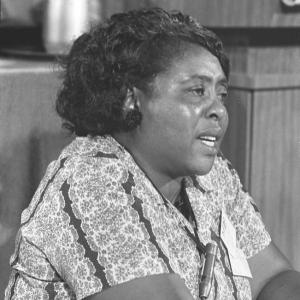Fannie Lou Hamer and Social Activism

This lesson will explain the actions, words, and rhetoric of Fannie Lou Hamer, including her enduring legacy at the 1964 Democratic Convention. After a pre-reading for historical context, short video, and modeling of a primary source, students will examine one of three excerpted speeches and complete a jigsaw activity. Ultimately, students will complete an analytical response, exploring how Fannie Lou Hamer and other civil rights activists were able to move the soul of the nation.
60 Minute Period (Two Periods if pre-reading is not done before).
1. Students will be able to synthesize the writing of Fannie Lou Hamer and evaluate how she was able to reach her audience and influence social change.
2. Students will evaluate the effectiveness of Fannie Lou Hamer as a persuasive speaker in the context of advocating for civil rights.
Students should be familiar in general terms with the Civil Rights Movement, the Civil Rights Act of 1964, the Voting Rights Act of 1965, and the political cleavage within the Democratic Party over the issue of Civil Rights. A pre-reading will be provided on Fannie Lou Hamer to help address these and other anticipated misconceptions.
1.Pre-Reading: Freedom Summer and Fannie Lou Hamer (Linked Article)
2. Fannie Lou Hamer, Testimony Before the Credentials Committee, Democratic National Convention, Atlantic City, NJ, August 22, 1964 (Excerpted)
3. Fannie Lou, Hamer, “I'm Sick and Tired of Being Sick and Tired”, Williams Institution CME Church, Harlem, NY, December 20, 1964 (Excerpted)
4. Fannie Lou Hamer, “I Don't Mind My Light Shining”, Greenwood, Mississippi, Fall, 1963 (Excerpted)
5. Fannie Lou Hamer, “We’re on Our Way”, Indianola, Mississippi, September, 1964. (Excerpted)
6. YouTube, Fannie Lou Hamer’s Powerful Testimony, PBS American Experience, June 2014.
Handouts:
Fannie Lou Hamer - Handout #1
1. Students, in preparation for class should complete the Pre-Reading on Fannie Lou Hamer (located under Materials #1). Questions to complete along with the reading:
- What inspired Fannie Lou Hamer to get politically involved?
- What was Freedom Summer?
- What happened at the Democratic National Convention in 1964?
2. Do Now.
Asking student to respond to the reflect on the following quote “There is one thing you have got to learn about our movement. Three people are better than no people.” - - Fannie Lou Hamer. Teacher should facilitate discussion between students and their interpretation of the quote. Connections to modern day protests should be encouraged as a thread line through American History.
3. YouTube Video.
Teacher should show PBS American Experience Video (Materials #6). Teacher should reveal the question before showing the 4-minute video. Question for consideration: “Why did President Lyndon Johnson not want the American people to hear Fannie Lou Hamer’s testimony to the Democratic Party? What does this reveal about the testimony, President Johnson and Fannie Lou Hamer?”
4. Inform students they will collaboratively read the testimony which compelled President Johnson to create an impromptu press conference. The transcript is included below. As a formative assessment, students will complete the following: What role did activists play in securing African-Americans’ full voting rights? (1-2 sentences/35 words). A sentence frame, a support tool for struggling students, is included below to help each child complete the formative assessment:
Sentence frame: Activists like Fannie Lou Hamer [used this tactic] and revealed [message] in order to [purpose]
If this is intended to be a two day lesson, this could be used as an exit ticket.
5. Jigsaw activity.
Students should be put in groups of 3-4 and they will read one of three speeches collaboratively which are located below. For their speech, students should prepare to discuss a) the gist or main ideas of the speech, b) rhetorical devices used to move Americans on the issue of civil rights, c) a powerful line that resonated with the group. After the groups have completed this, they should be reconfigured so each group has all three speeches to share. Given students an appropriate length of time to share out so students have the key ideas from all three speeches.
6. Closing Discussion.
The following questions are provided to help students with their final assessment on this lesson:
- What resonated with you about the words of Hamer? How was she able to gain supporters in the midst of the Civil Rights Movement?
- Why do you think activists like Hamer are less likely to be discussed in American history courses as compared to Martin Luther King Jr, Rosa Parks, or Malcolm X?
- In terms of democratic participation, do you think the goals of Hamer have been fulfilled?
Student Response 1-2 Pages:
How did the work, writings, and life of Fannie Lou Hamer alter the Civil Rights movement? What rhetorical strategies and arguments does she make to reach her goals? To what extent do you find them to be effective?
1. Zinn Education Project: Fannie Lou Hamer
2. Stand Up! Fannie Lou Hamer Documentary, Mississippi Democratic Party
D2.His.4.9-12. Analyze complex and interacting factors that influenced the perspectives of people during different historical eras.
D2.His.3.9-12. Use questions generated about individuals and groups to assess how the significance of their actions changes over time and is shaped by the historical context.
D2.His.1.9-12 Evaluate how historical events and developments were shaped by unique circumstances of time and place as well as broader historical contexts.
D2.His.8.9-12. Analyze how current interpretations of the past are limited by the extent to which available historical sources represent perspectives of people at the time
CCSS.ELA-LITERACY.RH.11-12.1
Cite specific textual evidence to support analysis of primary and secondary sources, connecting insights gained from specific details to an understanding of the text as a whole.
CCSS.ELA-LITERACY.RH.11-12.2
Determine the central ideas or information of a primary or secondary source; provide an accurate summary that makes clear the relationships among the key details and ideas.
CCSS.ELA-LITERACY.SL.9-10.4
Present information, findings, and supporting evidence clearly, concisely, and logically such that listeners can follow the line of reasoning and the organization, development, substance, and style are appropriate to the purpose, audience, and task
